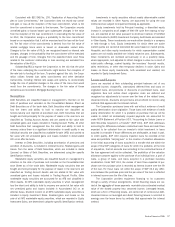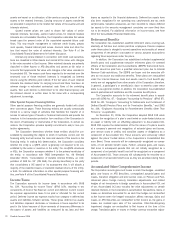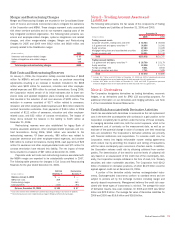Bank of America 2006 Annual Report Download - page 109
Download and view the complete annual report
Please find page 109 of the 2006 Bank of America annual report below. You can navigate through the pages in the report by either clicking on the pages listed below, or by using the keyword search tool below to find specific information within the annual report.Consistent with SEC SAB No. 105, “Application of Accounting Princi-
ples to Loan Commitments,” the Corporation does not record any unreal-
ized gain or loss at the inception of the loan commitment, which is the
time the commitment is issued to the borrower. The Corporation records
unrealized gains or losses based upon subsequent changes in the value
from the inception of the loan commitment. In estimating the fair value of
an IRLC, the Corporation assigns a probability to the loan commitment
based on an expectation that it will be exercised and the loan will be fund-
ed. The fair value of the commitments is derived from the fair value of
related mortgage loans which is based on observable market data.
Changes to the fair value of IRLCs are recognized based on interest rate
changes, changes in the probability that the commitment will be exercised
and the passage of time. Changes from the expected future cash flows
related to the customer relationship or loan servicing are excluded from
the valuation of the IRLCs.
Outstanding IRLCs expose the Corporation to the risk that the price
of the loans underlying the commitments might decline from inception of
the rate lock to funding of the loan. To protect against this risk, the Corpo-
ration utilizes forward loan sales commitments and other derivative
instruments, including interest rate swaps and options, to economically
hedge the risk of potential changes in the value of the loans that would
result from the commitments. The changes in the fair value of these
derivatives are recorded in Mortgage Banking Income.
Securities
Debt Securities are classified based on management’s intention on the
date of purchase and recorded on the Consolidated Balance Sheet as
Debt Securities as of the trade date. Debt Securities which management
has the intent and ability to hold to maturity are classified as
held-to-maturity and reported at amortized cost. Debt Securities that are
bought and held principally for the purpose of resale in the near term are
classified as Trading Account Assets and are stated at fair value with
unrealized gains and losses included in Trading Account Profits. All other
Debt Securities that management has the intent and ability to hold to
recovery unless there is a significant deterioration in credit quality in any
individual security are classified as available-for-sale (AFS) and carried at
fair value with net unrealized gains and losses included in Accumulated
OCI on an after-tax basis.
Interest on Debt Securities, including amortization of premiums and
accretion of discounts, is included in Interest Income. Realized gains and
losses from the sales of Debt Securities, which are included in Gains
(Losses) on Sales of Debt Securities, are determined using the specific
identification method.
Marketable equity securities are classified based on management’s
intention on the date of purchase and recorded on the Consolidated Bal-
ance Sheet as of the trade date. Marketable equity securities that are
bought and held principally for the purpose of resale in the near term are
classified as Trading Account Assets and are stated at fair value with
unrealized gains and losses included in Trading Account Profits. Other
marketable equity securities are accounted for as AFS and classified in
Other Assets. All AFS marketable equity securities in which management
has the intent and ability to hold to recovery are carried at fair value with
net unrealized gains and losses included in Accumulated OCI on an
after-tax basis. Dividend income on all AFS marketable equity securities is
included in Equity Investment Gains. Realized gains and losses on the
sale of all AFS marketable equity securities, which are recorded in Equity
Investment Gains, are determined using the specific identification method.
Investments in equity securities without readily determinable market
values are recorded in Other Assets, are accounted for using the cost
method and are subject to impairment testing as applicable.
Equity investments held by Principal Investing, a diversified equity
investor in companies at all stages of their life cycle from startup to buy-
out, are reported at fair value pursuant to American Institute of Certified
Public Accountants (AICPA) Investment Company Audit Guide and recorded
in Other Assets. These investments are made either directly in a company
or held through a fund. Equity investments for which there are active
market quotes are carried at estimated fair value based on market prices.
Nonpublic and other equity investments for which representative market
quotes are not readily available are initially valued at cost. Subsequently,
these investments are reviewed semi-annually or on a quarterly basis,
where appropriate, and adjusted to reflect changes in value as a result of
initial public offerings, market liquidity, the investees’ financial results,
sales restrictions, or other than temporary declines in value. Gains and
losses on these equity investments, both unrealized and realized, are
recorded in Equity Investment Gains.
Loans and Leases
Loans are reported at their outstanding principal balances net of any
unearned income, charge-offs, unamortized deferred fees and costs on
originated loans, and premiums or discounts on purchased loans. Loan
origination fees and certain direct origination costs are deferred and
recognized as adjustments to income over the lives of the related loans.
Unearned income, discounts and premiums are amortized to income using
methods that approximate the interest method.
The Corporation purchases loans with and without evidence of credit
quality deterioration since origination. Those loans with evidence of credit
quality deterioration for which it is probable at purchase that we will be
unable to collect all contractually required payments are accounted for
under AICPA Statement of Position 03-3, “Accounting for Certain Loans or
Debt Securities Acquired in a Transfer” (SOP 03-3). SOP 03-3 addresses
accounting for differences between contractual cash flows and cash flows
expected to be collected from an investor’s initial investment in loans
acquired in a transfer if those differences are attributable, at least in part,
to credit quality. SOP 03-3 requires impaired loans be recorded at fair
value and prohibits “carrying over” or the creation of valuation allowances
in the initial accounting of loans acquired in a transfer that are within the
scope of this SOP (categories of loans for which it is probable, at the time
of acquisition, that all amounts due according to the contractual terms of
the loan agreement will not be collected). The prohibition of the valuation
allowance carryover applies to the purchase of an individual loan, a pool of
loans, a group of loans, and loans acquired in a purchase business
combination. Under SOP 03-3, the excess of cash flows expected at pur-
chase over the purchase price is recorded as interest income over the life
of the loan. For those loans not within the scope of SOP 03-3 any differ-
ence between the purchase price and the par value of the loan is reflected
in interest income over the life of the loan.
The Corporation provides equipment financing to its customers
through a variety of lease arrangements. Direct financing leases are car-
ried at the aggregate of lease payments receivable plus estimated residual
value of the leased property less unearned income. Leveraged leases,
which are a form of financing leases, are carried net of nonrecourse debt.
Unearned income on leveraged and direct financing leases is accreted to
earnings over the lease terms by methods that approximate the interest
method.
Bank of America 2006
107
























